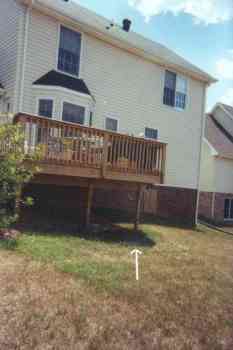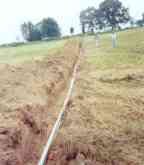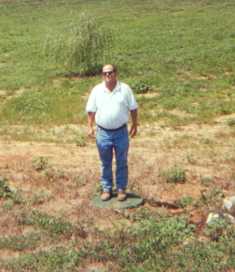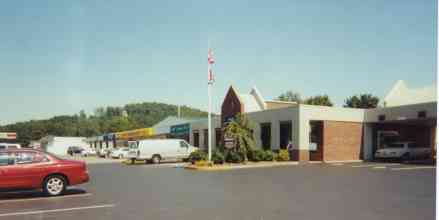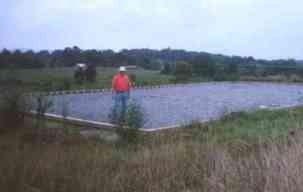Toms Creek Sewerage Options Working Group: Recommended decentralized systems
In 2001, a working group formed by the Town of Blacksburg issued a consensus report recommending STEP collection and two decentralized treatment systems as options for the wastewater treatment needs of the Toms Creek Basin. The Working Group examined system types through site visits and telephone interviews covering over 20 system installations nationwide, and screened results on criteria including reliability, effluent quality, long-term costs, and aesthetics.
STEP, as being used successfully for two and a half years in the largest new development in the Toms Creek Basin, could be expanded and integrated into the US 460 bypass force main option to serve development to build-out in the Toms Creek Basin sector of Blacksburg (North Main would already be covered to build-out once this line was constructed). This could be done using STEP hybrid, as described below, with STEP sewer lines connected to the bypass force main either through existing pumping stations or using a STEP pumping station (see figure and description below). It could also be done using STEP collection to a recirculating media filter secondary treatment unit, which, for 100 homes, has the size and appearance of a shrub-lined tennis court and is absolutely odor free (see below).
The Working Group found, in particular, that the “STEP hybrid” approach as would be used with the bypass sewer line option is proven and economical. Working Group members saw STEP hybrid systems extending five miles and up altitudes of 200-400 feet. The top regional expert in these systems, Michael Hines, who has consulted for the Town of Blacksburg, has confirmed that STEP hybrid would be workable and economical in conjunction with the conditions of the bypass sewer line option.
Following is a brief, non-technical description of these systems, the options recommended by consensus by the Working Group.
|
|
|
Home with STEP collection (tank top barely visible in grass) |
STEP (Septic Tank Effluent Pumping) and STEG (Septic Tank Effluent Gravity) are related wastewater collection methods that use a
“hi-test” waterproof septic tank with a solids filter to remove solids from sewage. Small collection lines, which can be laid with a trencher along road contours, then convey liquid to a secondary treatment system, such as a recirculating media filter or into a sanitary sewer main (a “hybrid” design).The Working Group found that STEP and STEG systems were operating successfully nationwide, and was particularly impressed with systems that are in extensive use in Tennessee. Shown here is a home in a Southridge, Tennessee development with a STEP tank in the back yard (arrow points to STEP tank top). Tanks are typically installed underground and barely visible.
|
|
|
STEP/STEG line. Can be laid with a trencher, following land contours |
Once liquid leaves the STEP or STEG tank, there are many inexpensive options for conveying the liquid to its ultimate destination through small lines. An often-used configuration is STEG tanks for clusters of homes gravity feeding into a pumping station. Unlike pumping stations of sanitary sewer systems, these are small, inexpensive, and can be placed underground. Shown below is a pumping station serving 40 homes that costs $6,500.
Systems in Tennessee are operated by a private utility at an average monthly cost per home of $30, including capital, operation, maintenance, and long-term capital upgrade costs for the complete system: STEP or STEG tanks, recirculating media filter treatment, and drip lines to disperse effluent water.
|
|
|
STEP pumping station serving 40 homes in Southridge, TN, cost $6,500 |
STEP and STEG is routinely used in developments and commercial areas zoned RR4 or denser. Shown right is a commercial area in Pegram, Tennessee served by STEP. Clustered STEP tanks with capacities of several thousand gallons may be used to serve units such as schools.
Both the U.S. Environmental Protection Agency and Blacksburg's Working Group concluded that STEP and decentralized treatment systems should be centrally maintained. Remote electronic sensors monitor performance of both STEP or STEG tanks and treatment systems. A common set of replacement parts is maintained to facilitate maintenance. The experience in both Blacksburg and Tennessee has been that these systems perform well and that the operation and maintenance burden is low.
|
|
|
A commercial block in Pegram, TN served by STEP |
|
|
|
Recirculating media filter (gravel) in Tall Oaks, TN serving 65 homes |
STEP effluent can also be conveyed to an on-site secondary treatment system. The system that received the highest recommendation from Blacksburg's sewerage options working group was the recirculating media filter. The term
“filter” is a misnomer; sewage is fully treated typically to advanced secondary effluent standards of BOD < 12, TSS < 1, FCU < 10 per 100 ml.Ultraviolet post-treatment can be added at a low cost if complete disinfection is required. (For comparison, a sanitary sewer facility typically releases effluent to secondary standards of < 30 BOD, < 30 TSS.) Effluent released by a recirculating media filter, shown right, is of very high purity and of river water quality.
A recirculating media filter to serve 100 homes has the size and appearance of a shrub-lined tennis court (size is 6,000 to 8,000 square feet to the system perimeter). The system shown above serves 65 homes in Tall Oaks, Tennessee. STEP effluent is premixed with aerated, circulating fluid to ensure that there is never any odor. Several site visits by the working group, in which members stood around systems in operation, confirmed that no odor was ever detected.
The Working Group reviewed both the design principles of recirculating media filters and data on operation and maintenance costs and incidence of downtime or problems. It found that the process used is inherently simple and reliable, and this was borne out by the low incidence of problems at system installations studied.
Treated water from a recirculating media filter is typically discharged through drip or drain field dispersal. The typical land requirements for a drip field for a 100-home system is 2 to 2.5 acres. A drip field may be used for hiking, athletics, any purpose except agriculture or development. Underground drip lines are invisible, as illustrated in the drip field shown right. For a development zoned, for example, RR1 clustered with 50% open space, as is the Toms Creek Basin in Blacksburg, for 100 homes, typically 2 to 2.5 of 50 acres of open space would be used for drip dispersal. Treated effluent may also be conveyed by water lines to a point source discharge point.
In conclusion, STEP collection was found to be reliable, economical and aesthetic by Blacksburg's Working Group, by experience nationwide, and for the past two and a half years, in a demonstration system in Blacksburg.
A STEP hybrid system allows homes to be economically connected to a sanitary sewer line miles away. STEP with secondary treatment by a recirculating media filter is ideal for low density clustered zoning. Both configurations are variants on what is called distributed sewer.
Distributed sewer is public sewer. It provides the same service, with no restrictions. This is simply an application of this centuries technology to wastewater engineering. Both mainframe and personal computers are widely used, but you probably do your accounting on a personal computer, and developers should understand that STEP is a reliable and economical option to support any planned projects.
For more information, see the contacts link above.
